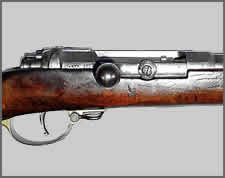- 01: Introduction
- 02: History
- 03: Propellants, Firearms, and Ammunition Development
- 04: Modern Firearms Manufacture
- 05: Small Arms Ammunition
- 06: Evidence Handling Procedures
- 07: Equipment and Instrumentation
- 08: Examination of Firearms
- 09: Cartridge and Shotshell Examination
- 10: Characterization and Evaluation of Fired Projectiles
- 11: Bullet Comparison and Identification
- 12: Gunshot Residue and Distance Determination
- 13: Toolmark Identification
- 14: Communicating Results
- Resources


Shoulder Arms
Home > Propellants, Firearms, and Ammunition Development > Evolution of Firearms > Repeating Firearms > Shoulder Arms

Mauser Model 1871 bolt-action service rifle
Cartridge firearms with long bolts, could be easily converted into repeaters. The original Mauser Model 1871 bolt-action service rifle was a single-shot firearm. In 1884, the basic design was modified, adding a long, tubular magazine under the barrel. A magazine spring put rearward pressure on the cartridges and a tilting tray under the bolt picked up a cartridge when the bolt handle was pulled to the rear. The resulting Mauser Model 71/84 repeater looked nearly identical externally to the older Model 1871; the extra parts required for repeating fit within the original pattern.
With fixed cartridges available, Oliver Winchester bought the rights to the Volcanic lever-action repeater from the firm of Robbins & Lawrence. The Volcanic was an early cartridge repeater that used caseless cartridges. The Henry repeating rifle saw limited service during the Civil War. In 1860, Henry made improvements to facilitate magazine loading. In 1866, the Henry design was further refined and sold by the new Winchester Repeating Arms Company. as the famous Winchester Model 1866. This was the first in a long and respected line of lever-action repeating rifles for Winchester.
These early Winchester repeaters linked the lever that moved the bolt to a lifter block just behind the magazine. When the lever was operated, the top of the block knocked the fired case from the chamber. A recess in the middle of the block held a cartridge that had been pushed there by the magazine spring. As the block continued to rise, the new cartridge was held in alignment with the chamber and the bolt could then push it forward.
A single lever cycle in the Winchester rifle accomplished the following:
- Extracted a fired case from the chamber
- Cocked the hammer
- Ejected the fired case out of the rifle
- Positioned the new cartridge
- Chambered the next cartridge
- Fed another round into the lifter block
Slide (Pump) Action
Some makers, including Colt and Remington, developed rifles that abandoned the lever and turn-bolt action concepts for a design that was more ergonomic when fast repeated shots were required. These slide-action rifles and shotguns had internal parts similar to a lever action, but these parts were connected to the forearm of the firearm where the shooter’s support hand rests. The forearm was moveable, not fixed as in previous shoulder-fired arms. A quick rearward movement of the supporting hand unlocked and opened the action for ejection and reloading.




